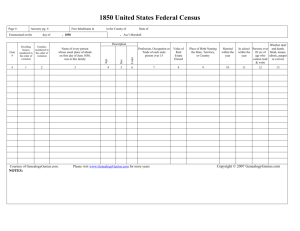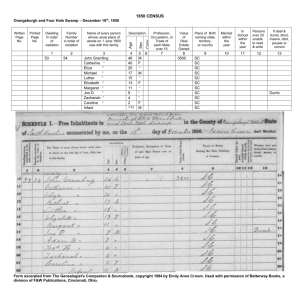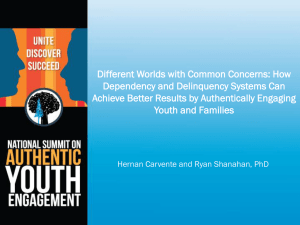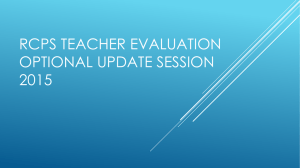MOTIONS PRACTICE IN JUVENILE COURT
advertisement
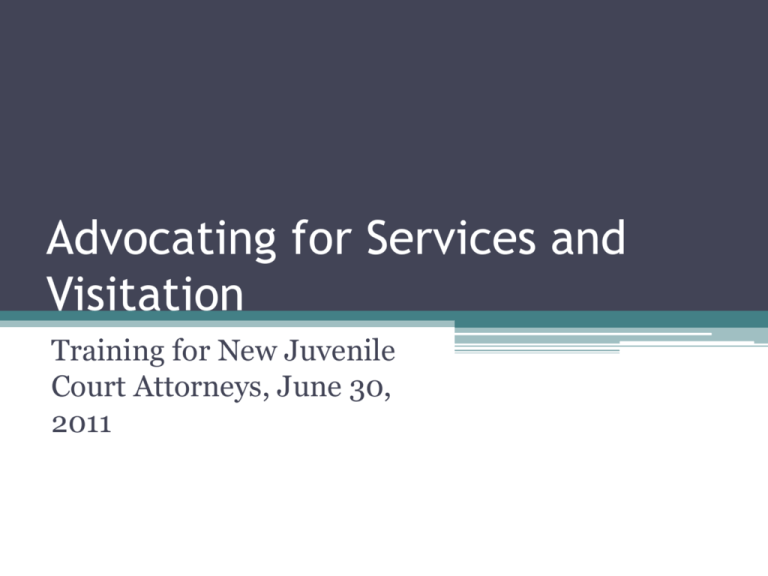
Advocating for Services and Visitation Training for New Juvenile Court Attorneys, June 30, 2011 Alphabet Soup • ACRS and TPCs: what are these? 1. When do they happen? Where? 2. Who is invited? 3. Youth over 18? • Sample redacted plan is part of case file What is a Treatment Plan/Case Plan Types of plans Purpose When does the plan get made what should treatment plan talk about (how to achieve reunification, services, visitation, timing, strengths/weaknesses.) who participates in the creation of the treatment plan? Treatment Plans and Specific Steps Hand out has specific steps form and treatment plan form What is the difference between these two items What is the lawyer’s role in addressing these two documents? Treatment Plans:Sources of Law • Sources of law: • 1. Adoption and Safe Families Act of 1997. 42 USCA 622; 42 USCA 675; 54 CFR 1355, 1356, 1357. • 2. CGS 17a-15 • 3. DCF Policy. What does Federal Law Say About Children’s Well-Being ? Adoption and Safe Families Act States must ensure that: "families have enhanced capacity to provide for their children's needs; children receive appropriate services to meet their educational needs; and children receive adequate services to meet their physical and mental health needs." (45 C.F.R. Part 1357 §1355.34 b(1)(iii)) Role of lawyer in TPC/ACR • work with your client to identify the obstacles to reunification • The client’s needs should be addressed in the Plan. • Make sure that obligations in specific steps are reflected in treatment plan • Make sure that everyone’s obligations and action steps and timelines are clear in the plan and reflect needs of case and specific steps obligations Role of lawyer in TPC/ACR • Make sure that the reunification date is properly estimated • Make sure that DCF’s obligations to make referrals in a timely manner to appropriate services is documented clearly. • visitation plan: C.G.S. 17a-10 requires documentation in treatment plan • Make sure your “view point” is documented if you disagree with something in the treatment plan. • copies Role of Lawyer at TPC/ACR • Remember: educational needs of child client • Plan should address special education needs/ early intervention (Birth to Three), preschool • Plan should address educational stability issues • Plan should address MDE recommendations Role of Lawyer • Remember: you can advocate for specific services for your client: e.g., services in the least restrictive environment, home or communitybased services, therapeutic foster care, services inside the foster home or biological home to assist with maintaining the placement, a mentor, an after-school program, job training, life skills courses, etc. Role of Lawyer at TPC/ACR • • • • What if I am unsure of what services to advocate for? Consult with colleagues prior to meeting Consult with providers working with family Ask DCF to consult with ARG team Research : 211 infoline What if I can’t attend the TPC/ACR? • • • • • Letter? Or ask DCF to reschedule Accessing records? CGS § 17a-28 RCSA 17a-15-3 Right to copy of plan within 10 days of meeting Visitation • Importance of in case • Changing needs in case Visitation • • • • legal standard for visitation (BIOC) statutory basis for visitation. CGS 17a-10a treatment plan and visitation what does DCF policy say about visitation Permanency Focus on visitation as a linchpin of permanency. • Research shows regular visitation increases the likelihood of successful reunification and reduces time in care and the negative effects of separation. • See Smariga, Margaret. Visitation with Infants and Toddlers in Foster Care:What Judges and Attorneys Need to Know.Washington, DC: ABA Center on Children and the Law and Zero to Three National. Policy Center, July 2007, 6. Visitation • enforcing the client’s right to visitation • increasing the frequency of visitation • terminating visitation Advocating for Services and Visitation Enforcing client’s rights to services and visitation: Motions Practice Motions Practice: Visitation CGS 17a-10a • Visitation shall occur as “frequently as reasonably possible, based upon consideration of the best interests of the child, including the age and developmental level of the child, and shall be sufficient in number and duration to ensure continuation of the relationship.” Motions Practice CGS 17a-10a • “The commissioner shall include in each child's plan of treatment information relating to the factors considered in making visitation determinations pursuant to this section.” Motions Practice: authority of juvenile court to issue orders CGS 46b-121(b) • “The Superior Court shall have authority to make and enforce such orders directed to parents … guardians, custodians or other adult persons owing some legal duty to a child, youth … as it deems necessary or appropriate to secure the welfare, protection, proper care and suitable support of a child, youth or youth in crisis subject to its jurisdiction or otherwise committed to or in the custody of the Commissioner of Children and Families.” Jurisdictional Issues: Can Court issue orders for services or visitation Visitation 1. Justin F. 116 Conn. App. 83 (2009). Affirmed trial court’s deference to DCF re visitation decisions after multiple court orders 2. Application of doctrine of concurrent/primary jurisdiction in juvenile court Jurisdictional Issues See for example In re Leighton V (jurisdiction and exhaustion) • DCF did not have exclusive jurisdiction over child’s request to be returned to the care of his grandmother. • Court has jurisdiction over “all proceedings concerning uncared for, neglected or dependant children and youth within this state , and that it is through the authority of the court that a child is placed in DCF’s custody in the first place. Conn. Gen. Stat. § 46b-129(d). • Exhaustion requirement must arise from either the statutory language or from an administrative scheme providing for agency relief. Court specifically noted that “[a]ny child placed with DCF may petition the court for appropriate relief” pursuant to the plain terms of Conn. Gen. Stat. § 17a-16(i). Motions Practice: authority of court to issue orders In re Leighton V., cont’d. • As the Leighton V. court noted, “[w]hile a few months may be a short time in the realm of litigation, it can feel like an eternity to a small child. … ‘[th]e delays that are annoying and frustrating to adults ... can permanently damage children and their families ... (Courts) should give highest priority to, and set rapid hearing schedules for, cases where delays will harm children irreparably ...” Id. (quoting Pamela B. v. Ment, 244 Conn. 296, 314 (1998).) Jurisdictional Issues • Court has broad authority to issue orders to anyone owing a “legal duty” to a child. C.G.S. 46b-121 • Court orders the “Specific Steps” which create the blue print for reunification and obligates the parties to work together to make reasonable efforts to reunify the family and provide the welfare of the child • Court has statutory authority to make preliminary visitation orders. C.G.S. 46b-129 • Court has statutory authority to direct services in support of reunification permanency plan. C.G.S. 46b-129(k) Motions Practice: Motions for Services • Making legal arguments for services • ASFA • Treatment Plan Motions Practice CGS 17a-15 Development of treatment and permanent placement plan. Review of plan. Modifications. Application for review. Hearing. Procedure. (a) The commissioner shall prepare and maintain a written plan for care, treatment and permanent placement of every child and youth under the commissioner's supervision, which shall include but not be limited to a diagnosis of the problems of each child or youth, the proposed plan of treatment services and temporary placement and a goal for permanent placement of the child or youth, which may include reunification with the parent, long-term foster care, independent living, transfer of guardianship or adoption. The child's or youth's health and safety shall be the paramount concern in formulating the plan. Motions Practice CGS 17a-15 continued (c) Any child or youth or the parent or guardian of such child or youth aggrieved by any provision of a plan prepared under subsection (a) of this section, or by the commissioner's decision upon review under subsection (b) of this section, or any child or youth or the parent or guardian of such child or youth aggrieved by a refusal of any other service from the commissioner to which he is entitled, shall be provided a hearing within thirty days following a written request for the same directed to the commissioner. Conn. Gen. Stat. 17a-16 (b) Each child or youth placed or treated under the direction of the Commissioner of Children and Families in any public or private facility shall receive humane and dignified treatment at all times, with full respect for his personal dignity and right to privacy, consistent with his treatment plan as determined by the commissioner. Motions Practice CGS 17a-16 continued (h) Each child or youth shall have a right to a hearing pursuant to procedures adopted by the commissioner, in accordance with sections 4176e to 4-181a, inclusive, before he is involuntarily transferred by the Commissioner of Children and Families to any facility outside the state of Connecticut. Motions Practice: when can you make motions? • Make oral motion at OTC preliminary hearing (CGS 46b-129) • Make subsequent written motion (see KidsCounsel pleadings bank e.g.) Motions Regarding Placement What if a child or youth is in an inappropriate placement? Motions Practice Motions for emergency relief/In Court Review (P.B. 34a-23; 34a-1) Motions Practice KidsCounsel Website • Motions Regarding Placement • Child & Minor Mother- Application for (ExParte) Temporary Injunction/Restraining Order as DOC (Word) • Emergency Motion for Placement as DOC (Word) • Motion for In-Court Review as PDF (Acrobat) as DOC (Word) • Motion for In-Court Judicial Review regarding Child's Prolonged Stay in Emergency Shelter as DOC (Word) • Motion for In-Court Review regarding Placement as PDF (Acrobat) as DOC (Word) • Motions Practice KidsCounsel website continued • Motion for Immediate Judicial Review & Order Maintaining Placement review & Planning as DOC (Word) • Motion for In-Court Judicial Review re: Removal of Child as DOC (Word) • Motion to Return Youth from Out of State Placement as DOC (Word) • Motion for Revocation of Out-of State Placement and Immediate Transfer to Connecticut as DOC (Word) • Motion for Temporary Injunction- Memorandum/Motion as DOC (Word) • Motion for Child-Application for (ExParte) Temporary Injunction/Restraining Order as DOC (Word) Motions Practice: Motions for independent evaluations Motions for independent evaluation (C.G.S. § 46b121; 46b-129) See also KidsCounsel website pleadings bank Motions Practice: Motions for Contempt Motions for contempt (P.B. § 34a-22; 34a-1) See also In re Leah S • Good luck!!


